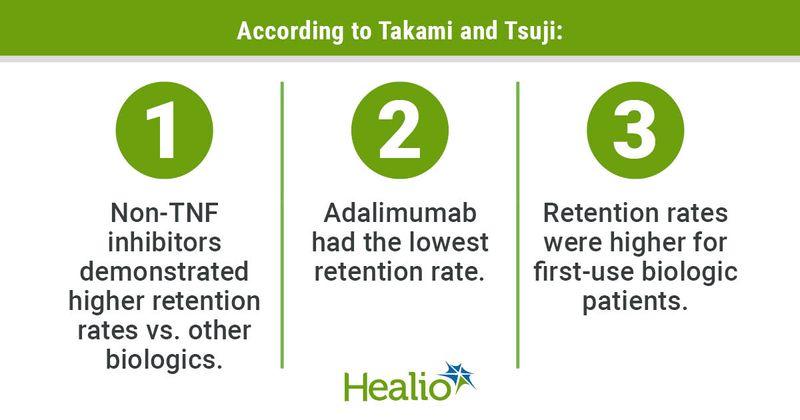Non-TNF inhibitors have higher retention rates in patients with rheumatoid arthritis
Key Takeaways:
- Etanercept was the most used biologic throughout the study.
- Tocilizumab had the highest retention rate, while adalimumab had the lowest.
Patients with rheumatoid arthritis are increasingly receiving non-TNF inhibitors, which additionally demonstrate higher retention rates, compared with other biologics, according to data published in Nature Scientific Reports.
“Although each biologic has its own characteristics, there are no clear criteria for selecting the one to use, and the choice depends on the decision of the clinician,” Kenji Takami and Shigeyoshi Tsuji, both of Nippon Life Hospital, in Osaka, Japan, wrote. “Since the ORAL Surveillance [study] had been reported, the use of biologics has been considered over JAK inhibitors, and it is expected that there will be increasing cases concerned [with] the choice of biologics.”

To analyze aid rheumatologists in choosing between various biologics, Takami and Tsuji examined the retention rates and reasons for dropout for biologics prescribed at Nippon Life Hospital since October 2003. They examined 393 cases and 605 prescriptions, 378 of which were first-time biologic prescriptions. Janus kinase inhibitors and sarilumab (Kevzara, Sanofi) were excluded.
According to the researchers, etanercept (Enbrel, Amgen) was the most used biologic throughout the study. After etanercept, adalimumab (Humira, Abbvie) and tocilizumab (Actemra, Genentech) were most common. However, in cases after 2010, adalimumab became less common, and abatacept (Orencia, Bristol Myers Squibb) rose in popularity.
Meanwhile, tocilizumab demonstrated the highest retention rate, followed closely by abatacept and etanercept. In biologic naïve patients, the retention rates of anti-TNF monoclonal antibodies were lower, including certolizumab pegol (Cimzia, UCB), golimumab (Simponi Aria, Janssen), infliximab (Remicade, Janssen) and adalimumab, in order of highest to lowest.
The most common reasons for dropout included primary and secondary ineffectiveness and infection. In biologic naïve patients, the dropout rate due to primary inefficacy was lower compared with second or later use patients.
“We believe that the various data in this study will be useful to clinicians who have the opportunity to use biologics in clinical practice,” Takami and Tsuji wrote. “In summary, we reviewed the details of the use of biologics for RA at our institution. The aging of the patients and the accompanying background factors were considered to influence the choice of biologics. Retention rates were higher for non-TNF inhibitors. As the options are now expanding with the release of sarilumab and JAK inhibitors, further studies including these drugs are needed in the future.”
